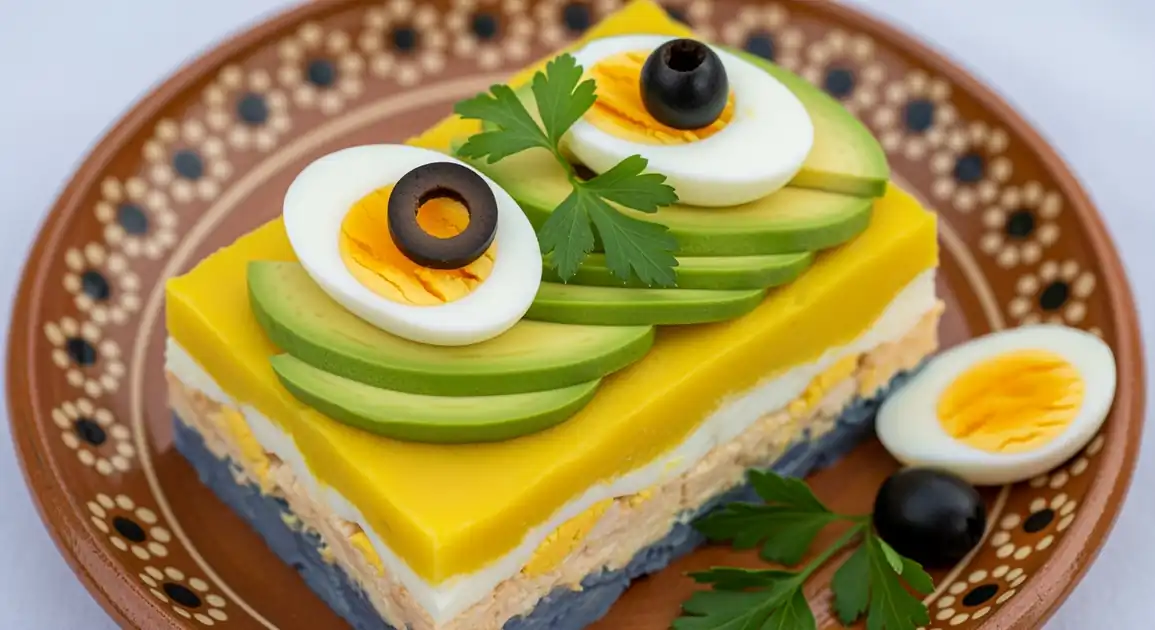Causa
Causa Limeña

Description
Lima, Peru's capital and gastronomic heart, is where Causa has been most elaborately developed and refined. The dish gets its name 'Causa Limeña' from its strong association with the city, where it has evolved from a simple potato dish to an artistic culinary creation served in restaurants ranging from humble 'huariques' to fine dining establishments. In Lima, you'll find the most creative and technically perfect versions of this national dish.
Dietary Information
Serving information
Serving style
In Lima, presentation varies widely: traditional restaurants serve generous rectangular portions, while upscale venues may present artfully constructed individual portions with elaborate garnishes and complementary sauces.
Quick facts
Traditional restaurants: Lunch (12 PM - 4 PM), Dinner (7 PM - 11 PM). Market food stalls: Morning to afternoon (9 AM - 3 PM). Trendy districts may have extended evening hours.
Safety Tips
What to Look For
-
Proper refrigeration
As a cold dish containing mayonnaise and proteins, Causa must be kept refrigerated. Look for restaurants with proper cold storage.
-
Clean, organized preparation areas
Since Causa involves multiple ingredients and handling, kitchen cleanliness is important.
-
Fresh garnishes
Fresh-looking avocado, vibrant herbs, and properly cooked eggs indicate overall freshness.
-
Reputable establishments with high turnover
Popular restaurants ensure the ingredients don't sit too long before serving.
-
Proper separation from raw ingredients
In market settings, ensure Causa is prepared away from raw meats or seafood.
What to avoid
-
Causa sitting at room temperature for long periods
Due to mayonnaise content, Causa should not be left unrefrigerated, especially in warm weather.
-
Discolored or dried-out appearance
Browning avocados, darkened potatoes, or dried edges indicate it's been prepared too far in advance.
-
Strong or sour smell
Fresh Causa should have a pleasant, mild aroma. Any sour smell could indicate spoilage of mayo or protein fillings.
-
Cross-contamination risks
Be cautious of vendors handling money and food without washing hands or using appropriate utensils.
-
Very low prices at questionable establishments
Quality ingredients for Causa cost more; suspicious bargains might indicate cut corners on freshness or refrigeration.
Price information
Price range
Budget tips
- Local 'menú' restaurants offer Causa as part of their fixed price meals (15-25 PEN total).
- Working-class districts like Surquillo or La Victoria have affordable 'huariques' (small local restaurants) with excellent Causa for 15-20 PEN.
- Visit during lunch hours when many restaurants offer promotional prices.
- Avoid hotel restaurants where Causa can cost 35-45 PEN without necessarily being better.
Value indicators
- Vibrant yellow color indicating proper use of fresh ají amarillo.
- Generous filling-to-potato ratio.
- Perfectly smooth potato texture without lumps.
- Creative presentation with careful garnishes.
- Accompaniments like extra sauce or crispy elements.
Where to Find This Dish
Miraflores
This tourist-friendly district has numerous restaurants serving high-quality Causa, from traditional to avant-garde interpretations.
Parque Kennedy, Larcomar, Huaca Pucllana
Lunch (1 PM - 3 PM), Dinner (7 PM - 10 PM)
Barranco
The bohemian district features trendy restaurants with creative Causa variations.
Puente de los Suspiros, Plaza Barranco
Lunch (1 PM - 3 PM), Dinner (8 PM - 11 PM)
San Isidro
Upscale district with fine dining restaurants offering premium versions of Causa.
Olivar Park, Financial district
Business Lunch (1 PM - 3 PM), Dinner (7:30 PM - 10:30 PM)
Surquillo Market
The 'Gastronomic Market' section has stalls selling homestyle Causa by the portion.
Mercado N°1 de Surquillo
Morning (10 AM - 1 PM)
Central Lima
Traditional 'centro' restaurants often serve classic versions of Causa Limeña.
Plaza de Armas, Barrio Chino
Lunch (12 PM - 3 PM)
Vendor Tips
- Look for restaurants displaying 'Causa Limeña' specifically as a specialty.
- Established cevicherías often make excellent Causa, especially seafood versions.
- Check if a restaurant has won awards at Peru's gastronomic festivals like Mistura.
- Restaurants with 'cocina novoandina' or 'cocina de autor' might offer innovative but excellent Causa variations.
How to Order
Regional Variations
-
Causa Limeña Gourmet
(Causa Limeña Gourmet)
High-end interpretations featuring premium ingredients like king crab, lobster, or truffle oil, often found in Lima's top restaurants.
-
Nikkei Causa
(Causa Nikkei)
A fusion reflecting Lima's Japanese influence, often incorporating sushi elements, raw fish, or wasabi.
-
Causa Individual Creativa
(Causa Individual Creativa)
Small, individually molded portions with artistic presentations, popular in Lima's innovative restaurants.
-
Causa Bar
(Barra de Causas)
A modern concept in some Lima restaurants featuring a selection of mini-causas with different fillings, similar to a tasting menu.
Cultural context
History
Causa has deep patriotic roots in Peruvian history, with its name believed to derive from 'la causa' (the cause) during Peru's war for independence in the early 19th century. During this period, women prepared this potato-based dish to feed soldiers fighting 'for the cause.' However, its origins may date back even further to pre-Columbian times, as potatoes are native to the Andes. The modern version evolved in Lima, incorporating coastal seafood influences and European techniques to create the layered presentation that's now emblematic of Peruvian gastronomy.
Local significance
In Lima, Causa has transcended its humble origins to become a canvas for culinary creativity. It represents the city's status as Peru's gastronomic capital and showcases the fusion of indigenous ingredients with European techniques.
Eating customs
- Limeños often judge a restaurant's quality by its Causa.
- Adding extra lime juice or ají sauce according to personal preference is common.
- Usually eaten with a fork, cutting through all layers to appreciate the combination of flavors.